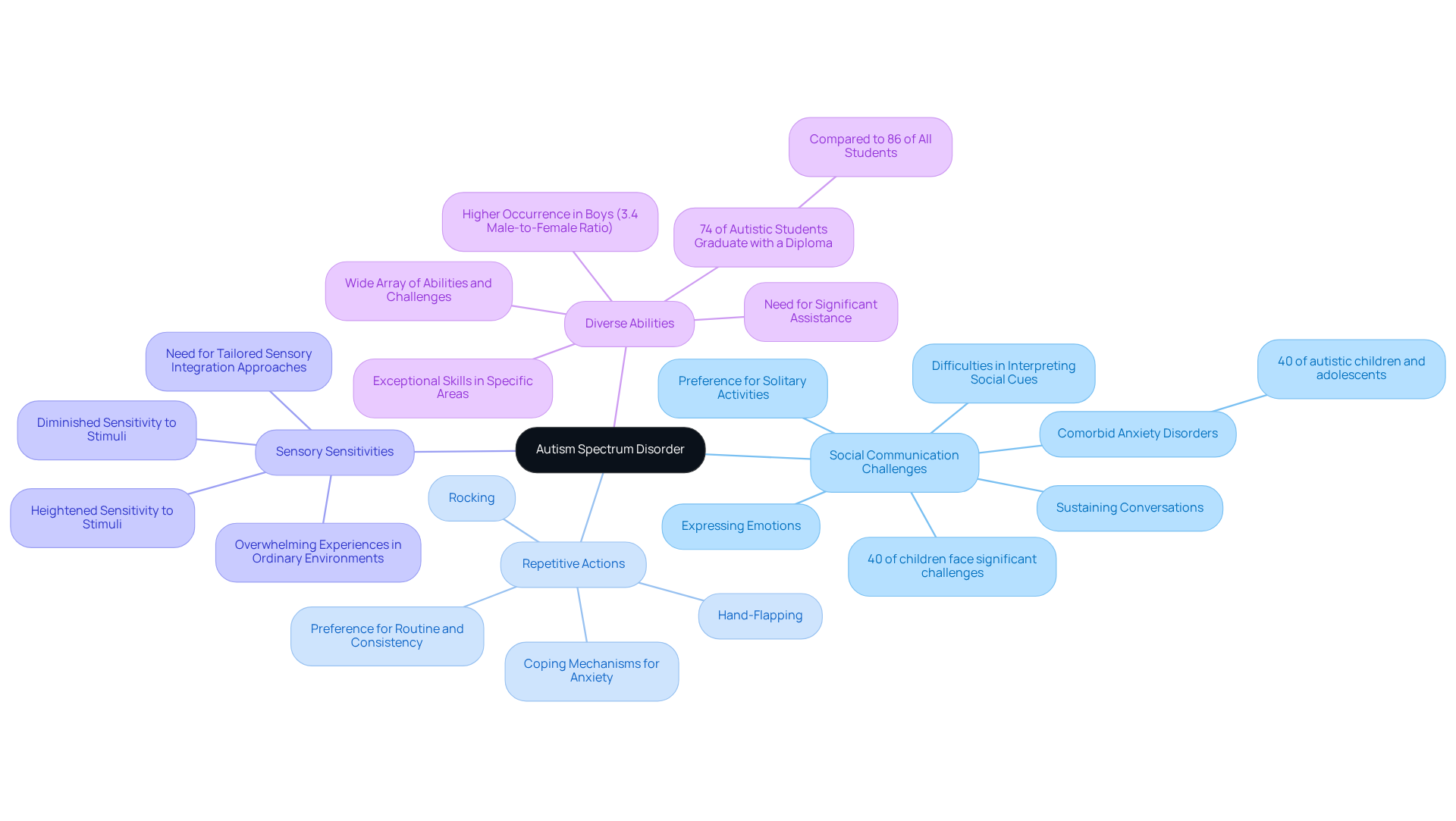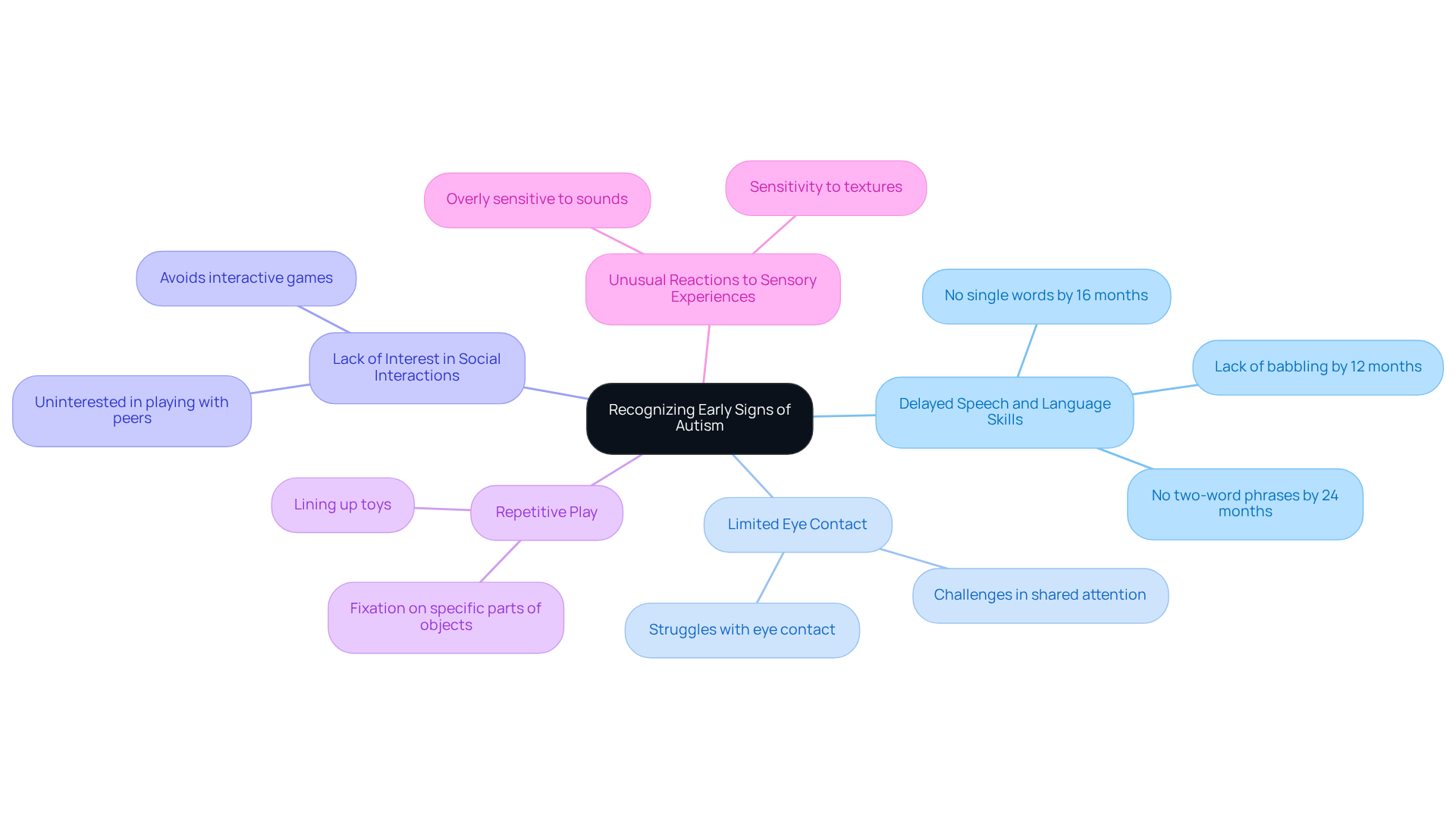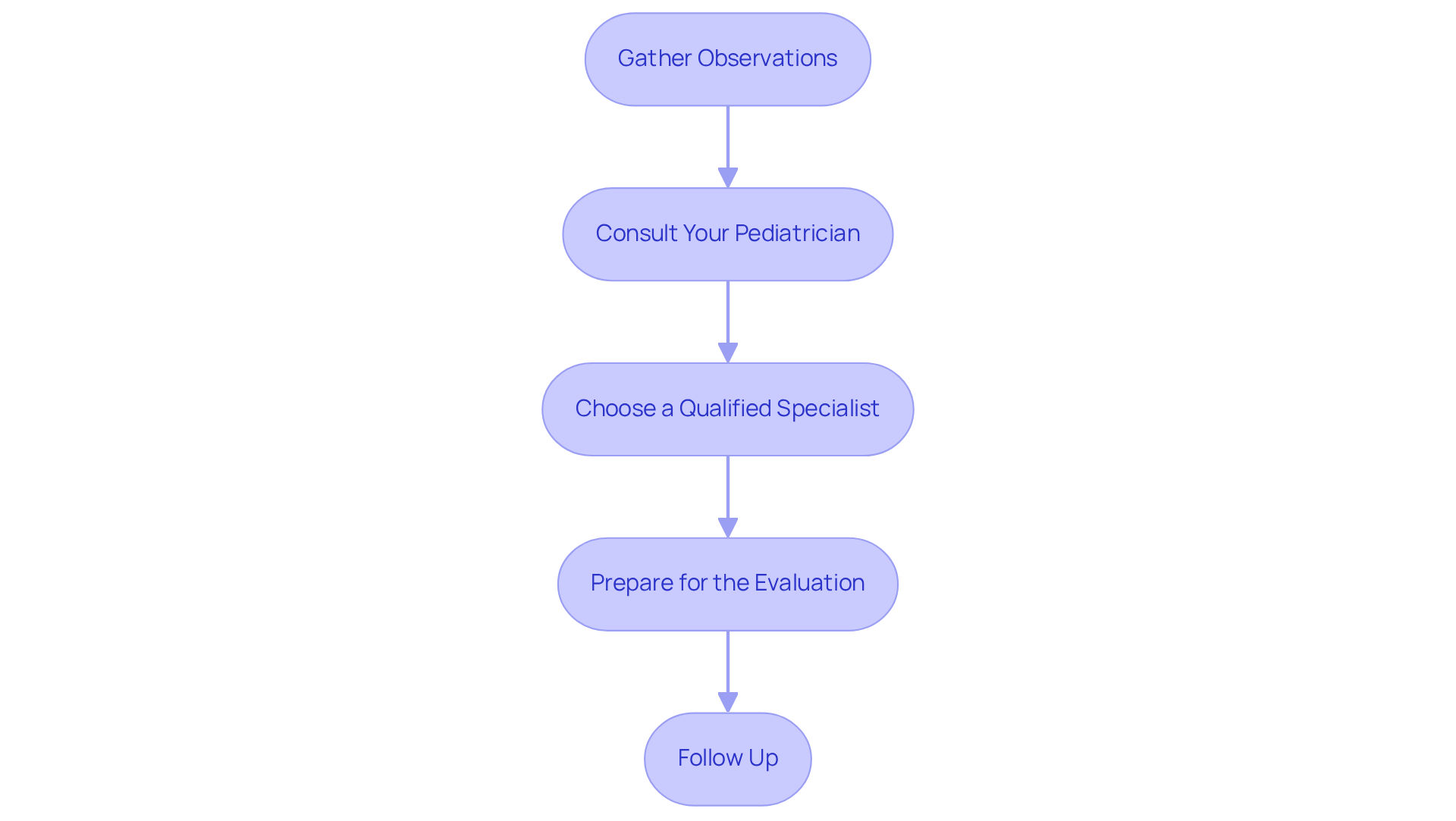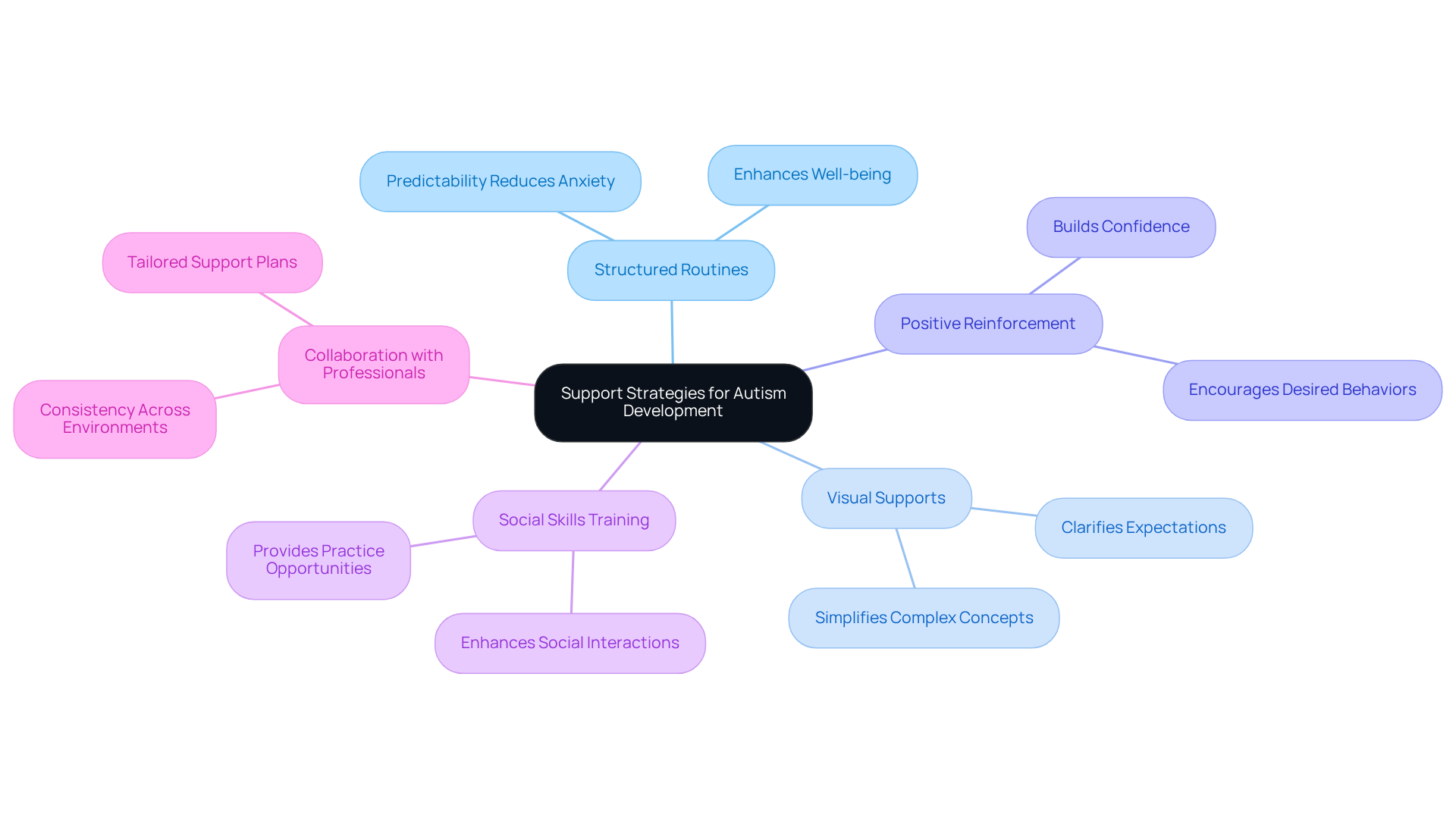Overview
This article explores a vital question for many parents: can autism develop over time? It highlights the significance of recognizing early signs and seeking the right support. Autism is primarily a developmental disorder diagnosed in early childhood, but being aware of key indicators—like delayed speech, limited social interaction, and sensory sensitivities—can empower parents to identify potential concerns early on. By understanding these signs, parents can navigate the assessment process more effectively and ensure their child receives the support they need.
As you read on, consider your own experiences. Have you noticed any of these signs in your child? Sharing your journey can help others feel less alone and more supported. Remember, reaching out for help is a strong and caring step towards understanding your child's needs.
In conclusion, recognizing these early indicators is crucial. If you have concerns, don’t hesitate to seek support. There are resources available to guide you through this journey, ensuring your child has the best possible outcomes.
Introduction
Autism Spectrum Disorder (ASD) is a complex developmental condition that affects individuals in diverse ways, often leading to heartfelt questions about its origins and manifestations.
Understanding the signs and characteristics of autism is crucial—not just for parents, but also for educators and healthcare professionals. Early recognition can significantly impact the support and interventions provided, making it essential to stay informed.
Yet, a lingering question persists: Can autism develop later in life, particularly in adults?
This article delves into the core traits of autism, highlighting key indicators to monitor from childhood through adulthood.
We aim to offer guidance on navigating the assessment process, ultimately empowering individuals and families to seek the support they need.
Understand Autism: Core Characteristics and Spectrum Overview
Autism Spectrum Disorder (ASD) is a developmental disorder characterized by a wide range of symptoms that affect communication, behavior, and social interaction. Understanding the fundamental traits of this condition is crucial for both parents and professionals. Let’s explore some key aspects:
- Social Communication Challenges: Many individuals with autism encounter difficulties in interpreting social cues, sustaining conversations, and expressing their emotions. They often prefer solitary activities over social interactions. Research shows that about 40% of children with ASD face significant challenges in social communication, and around 40% of autistic children and adolescents also have at least one comorbid anxiety disorder. This underscores the importance of targeted support.
- Repetitive Actions: A common trait among individuals with autism is the presence of repetitive movements or actions, such as hand-flapping, rocking, or a strong preference for routine and consistency. These behaviors can serve as coping mechanisms in response to anxiety or sensory overload, providing comfort in challenging situations.
- Sensory Sensitivities: Many individuals on the spectrum exhibit either heightened or diminished sensitivity to sensory stimuli, including sounds, lights, and textures. This can lead to overwhelming experiences in environments that may seem ordinary to others, highlighting the need for tailored approaches to sensory integration.
- Diverse Abilities: Autism is a spectrum disorder, meaning individuals can showcase a wide array of abilities and challenges. While some may have exceptional skills in specific areas, others may require significant assistance with daily activities. Notably, the occurrence of this condition is higher in boys, with a male-to-female ratio of about 3.4. Furthermore, 74% of autistic students in the U.S. receive a diploma, compared to 86% of all students, emphasizing the importance of recognizing these traits to enhance educational support.
By familiarizing yourself with these characteristics, you can gain a deeper understanding of the behaviors and needs of individuals on the spectrum. This knowledge paves the way for recognizing signs and seeking appropriate support, fostering a more inclusive environment for those affected.

Recognize Early Signs of Autism: Key Indicators to Monitor
Recognizing the early signs of developmental disorders is crucial for a young person's growth and well-being, as it raises the question of whether can u develop autism. As parents, understanding these indicators can guide you in supporting your child's development. Here are some key signs to keep an eye on:
- Delayed Speech and Language Skills: Look for a lack of babbling by 12 months, no single words by 16 months, or no two-word phrases by 24 months. These milestones can u develop autism as important markers in language development.
- Limited Eye Contact: Children may struggle with eye contact or find it challenging to engage in shared attention with others, leading to questions about whether can u develop autism. This can impact their social interactions.
- Lack of Interest in Social Interactions: Notice if your child seems uninterested in playing with peers or participating in interactive games. This could indicate a need for additional support in social skills.
- Repetitive Play: Pay attention to patterns of repetitive play, such as lining up toys or fixating on specific parts of objects rather than engaging with them as a whole. This behavior can be a sign of developmental challenges.
- Unusual Reactions to Sensory Experiences: Be mindful of your child’s responses to sensory stimuli, like being overly sensitive to sounds or textures. These reactions can affect their comfort and interactions with the world around them.
By being vigilant and monitoring these signs, you can take the first steps toward understanding if can u develop autism and seeking support and intervention. Early action can lead to better developmental outcomes for your child, paving the way for a brighter future.

Seek Professional Evaluation: Navigating the Autism Assessment Process
Navigating the autism assessment process can feel overwhelming, but understanding the steps involved can truly simplify your journey.
-
Gather Observations: Begin by documenting your child's behaviors, milestones, and any concerns you may have. This information is invaluable during the evaluation, as it provides professionals with a clearer understanding of your unique situation.
-
Consult Your Pediatrician: Schedule an appointment with your child's pediatrician to share your concerns. Pediatricians play a vital role in the early identification of developmental disorders and can provide referrals to specialists, guiding you through the evaluation process.
-
Choose a Qualified Specialist: Look for professionals who have experience diagnosing developmental disorders, such as pediatric psychologists, developmental pediatricians, or neurologists. The right specialist can significantly impact the accuracy and efficiency of the diagnosis. Dr. Sharief Taraman emphasizes the importance of expanding and empowering the pool of providers for evaluation, highlighting the need to seek qualified specialists.
-
Prepare for the Evaluation: Bring your observations and any relevant medical history to the appointment. Be ready to answer questions about your child's development and behavior, as this information is critical for an accurate assessment. Research indicates that while autism can develop, it can be reliably diagnosed by age 2, yet the average diagnosis age in the U.S. is around 5 years. This underscores the importance of timely evaluations. Additionally, consider using the Modified Checklist for Autism in Toddlers during your preparation; it is a validated screening tool used during 18-month check-ups to identify potential autism risk.
-
Follow Up: After the evaluation, discuss the results with the specialist. If a diagnosis is made, inquire about suggested interventions and assistance services. Understanding the next steps is crucial for accessing the support your child may need.
By following these steps, you can effectively manage the evaluation process and ensure your child receives the essential support they deserve. This proactive approach is vital, especially considering that 8% of autistic students in the U.S. do not complete high school, while 74% earn a diploma. Early intervention and support are key. Moreover, it's important to acknowledge that 1 in every 36 children in the United States can develop autism and other developmental disorders as of May 2024, and 83% of facilities report that evaluations for these conditions take more than 3 hours, setting realistic expectations about the time investment required.

Implement Support Strategies: Enhancing Development and Managing Challenges
Implementing support strategies is vital for nurturing the growth of individuals, especially considering the question of can u develop autism. Let’s explore some effective approaches that can make a meaningful difference:
- Structured Routines: Establishing consistent daily routines offers predictability, significantly reducing anxiety and improving behavior. Therapists emphasize that organized routines help children feel secure, allowing them to understand what to expect throughout their day. By creating these routines, parents can enhance the well-being of their children with autism.
- Visual Supports: Utilizing visual schedules, charts, and social stories can greatly aid in understanding and communication. Visual aids simplify complex concepts and clarify expectations, making it easier for children to navigate their environment. These resources empower young individuals to grasp concepts and expectations more readily.
- Positive Reinforcement: Encouraging desired behaviors through positive reinforcement—such as praise or rewards—motivates children to engage in appropriate conduct. This approach not only builds confidence but also reinforces learning. Positive reinforcement serves as a key behavior management technique, helping to reduce tantrums and meltdowns in children.
- Social Skills Training: Involving children in social skills training programs or playgroups enhances their social interactions and communication abilities. These settings provide valuable opportunities for practice and feedback in a nurturing environment.
- Collaboration with Professionals: Working closely with therapists, educators, and support staff is crucial in developing a comprehensive support plan tailored to your child’s unique needs. This partnership ensures that strategies remain consistent and effective across various environments, highlighting the importance of teamwork in supporting your child’s development.
By implementing these strategies, parents can cultivate a nurturing environment that fosters growth and development, empowering their children to navigate the challenges associated with the question of can u develop autism. Together, we can create a supportive community that uplifts our children and helps them thrive.

Conclusion
Understanding Autism and its multifaceted nature is essential for fostering a supportive environment for individuals on the spectrum. This article highlights the importance of recognizing the signs of Autism Spectrum Disorder (ASD) and emphasizes that while autism is often identified in early childhood, its characteristics can manifest in various ways throughout life. By gaining insights into the core traits of autism, caregivers and professionals can better support individuals, ensuring they receive the necessary interventions and understanding.
Key points discussed include the core characteristics of autism, such as:
- Social communication challenges
- Sensory sensitivities
- The presence of repetitive behaviors
The article also underscores the significance of early detection, outlining crucial signs to monitor in children, such as:
- Delayed speech
- Limited eye contact
Furthermore, navigating the autism assessment process is made clearer through practical steps that include:
- Gathering observations
- Consulting specialists
- Preparing for evaluations
Finally, implementing effective support strategies, such as:
- Structured routines
- Social skills training
can significantly enhance the development and well-being of individuals with autism.
Ultimately, the journey toward understanding and supporting individuals with autism is a collective effort. By recognizing the signs, seeking timely evaluations, and implementing tailored support strategies, society can create an inclusive environment where individuals on the spectrum can thrive. The call to action is clear: remain vigilant, informed, and proactive in supporting those with autism, as early intervention and understanding can lead to improved outcomes and a brighter future for all.
Frequently Asked Questions
What is Autism Spectrum Disorder (ASD)?
Autism Spectrum Disorder (ASD) is a developmental disorder characterized by a wide range of symptoms that affect communication, behavior, and social interaction.
What are the social communication challenges faced by individuals with autism?
Individuals with autism often have difficulties interpreting social cues, sustaining conversations, and expressing their emotions. Many prefer solitary activities over social interactions, and approximately 40% face significant challenges in social communication.
How common are comorbid anxiety disorders among autistic children?
Around 40% of autistic children and adolescents also have at least one comorbid anxiety disorder.
What are some common repetitive actions seen in individuals with autism?
Common repetitive actions include hand-flapping, rocking, and a strong preference for routine and consistency. These behaviors can serve as coping mechanisms in response to anxiety or sensory overload.
What are sensory sensitivities in individuals on the autism spectrum?
Many individuals on the spectrum exhibit either heightened or diminished sensitivity to sensory stimuli, such as sounds, lights, and textures, which can lead to overwhelming experiences in seemingly ordinary environments.
How does the spectrum nature of autism affect individual abilities?
Autism is a spectrum disorder, meaning individuals can display a wide array of abilities and challenges. Some may have exceptional skills in specific areas, while others may require significant assistance with daily activities.
What is the male-to-female ratio in autism occurrence?
The occurrence of autism is higher in boys, with a male-to-female ratio of about 3.4.
What percentage of autistic students in the U.S. receive a diploma?
Approximately 74% of autistic students in the U.S. receive a diploma, compared to 86% of all students.
Why is it important to understand the characteristics of autism?
Familiarizing yourself with the characteristics of autism helps in recognizing signs and seeking appropriate support, fostering a more inclusive environment for individuals affected by the condition.




